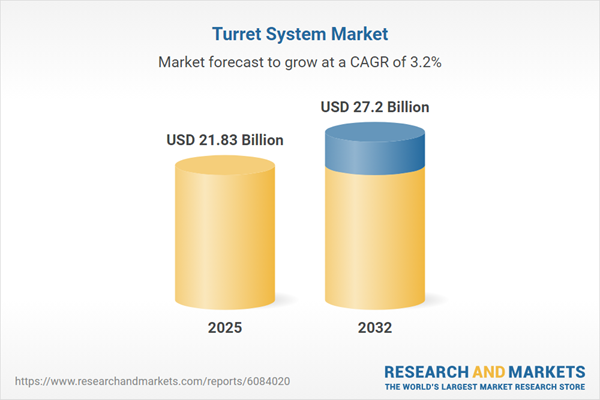Speak directly to the analyst to clarify any post sales queries you may have.
The turret system market is undergoing significant transformation as manufacturing leaders seek solutions that enhance digitalization, automation, and operational resilience. For senior decision-makers, comprehensive research and actionable insights into this sector are essential to drive efficiency and stay competitive in evolving production landscapes.
Market Snapshot: Turret System Market Overview
The Turret System Market is growing from USD 21.16 billion in 2024 to USD 21.83 billion in 2025 and is projected to reach USD 27.20 billion by 2032, reflecting a CAGR of 3.18%. Increased demand for precision machining, higher automation rates, and the focus on robust supply chains are fueling this momentum. Growth is further propelled by regulatory compliance, technological advancements, and investments in modern manufacturing ecosystems, with advanced turret solutions central to large-scale, high-value production initiatives across sectors.
Scope & Segmentation
This report delivers in-depth analysis, addressing a broad range of market dimensions relevant for strategic planning:
- Product Types: Includes fixed turret, gang turret, rotary turret, and slot turret—each catering to varying requirements for operational speed, flexibility, and process adaptability within manufacturing environments.
- Technology Types: Covers electromechanical, hydraulic, and pneumatic systems, each offering distinct advantages for accuracy, power application, and energy consumption.
- Applications: Focuses on aerospace (encompassing both commercial and defense aircraft), automotive (such as chassis, engine, and transmission components), general engineering (spanning consumer and electronics), and medical (prosthetics and surgical instrument manufacturing).
- End Users: Segments include the aftermarket for ongoing maintenance, repair, and replacement, as well as OEMs across aerospace and automotive sectors, where customization and integration are critical for manufacturing continuity.
- Sales Channels: Analyzes strategies including direct sales, distributor partnerships, and online retail, serving both large-scale procurement and emerging small- to medium-sized buyers.
- Regions: Provides insight into key geographies: Americas (notably the United States, Canada, and Brazil), Europe, Middle East & Africa (with major markets including Germany, France, and Saudi Arabia), and Asia-Pacific (particularly China, India, and Japan), highlighting region-specific trends and opportunities.
Key Takeaways for Turret System Market Leaders
- Intelligent control systems and modular tooling are reshaping production strategies, fostering greater process flexibility and enabling real-time optimization of manufacturing workflows.
- The selection of materials and the management of supplier partnerships are increasingly central to competitive strategy, with the importance of compliance and sustainability growing as supply chains expand.
- Electromechanical turret systems are being adopted for their precision and energy efficiency, while hydraulic alternatives continue to serve applications demanding durability and high torque output.
- Automotive and aerospace sectors require highly specialized turret configurations, reflecting distinct operational needs and adherence to evolving manufacturing and certification standards.
- Sales models are evolving as digital platforms support streamlined quoting and financing, enabling access to emerging markets and meeting the needs of smaller-scale buyers.
- Regional market dynamics shape growth: the Americas drive automation initiatives, EMEA leverages expertise in precision engineering, and Asia-Pacific scales production for diversified industry requirements.
Impact of United States Tariff Policies
Recent changes to United States tariffs on steel and aluminum are altering sourcing strategies, spurring manufacturers to diversify suppliers and consider dual-sourcing to buffer against price volatility. These shifts introduce more complex logistics, longer lead times, and heightened procurement requirements centered around regulatory adherence. In response, adaptive supply chain planning, collaborative supplier relationships, and advanced forecasting are enhancing overall resilience, driving greater transparency, and strengthening the market’s ability to manage disruptions.
Methodology & Data Sources
Research for this report is built on structured interviews with senior executives, engineering specialists, and procurement leaders. These primary data sources are integrated with insights from industrial publications and proprietary finance databases. Both quantitative segmentation and scenario analysis are complemented by value chain mapping and peer reviews to uphold data credibility and strategic accuracy.
Why This Report Matters
- Facilitates benchmarking for manufacturing leaders to evaluate organizational positioning within rapidly advancing technologies and complex supplier ecosystems.
- Offers robust segmentation to refine go-to-market strategies by product, application, or region, supporting more precise business development initiatives.
- Enables prioritization of investments and proactive risk management—particularly valuable given shifting trade environments and evolving regulatory demands.
Conclusion
As the turret system market transforms through new technologies, adaptive supply strategies, and diverse regional influences, decision-makers with access to granular segmentation and strategic insights will be best equipped to build resilient and forward-focused plans in this sector.
Table of Contents
3. Executive Summary
4. Market Overview
7. Cumulative Impact of Artificial Intelligence 2025
Companies Mentioned
The companies profiled in this Turret System market report include:- IPC Systems, Inc.
- BT Group plc
- Unigy, Inc.
- Cisco Systems, Inc.
- Avaya Inc.
- Ribbon Communications Inc.
- NEC Corporation
- Huawei Technologies Co., Ltd.
- Alcatel-Lucent Enterprise
- Siemens AG
Table Information
| Report Attribute | Details |
|---|---|
| No. of Pages | 194 |
| Published | October 2025 |
| Forecast Period | 2025 - 2032 |
| Estimated Market Value ( USD | $ 21.83 Billion |
| Forecasted Market Value ( USD | $ 27.2 Billion |
| Compound Annual Growth Rate | 3.1% |
| Regions Covered | Global |
| No. of Companies Mentioned | 11 |









